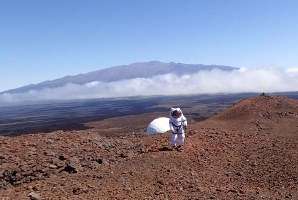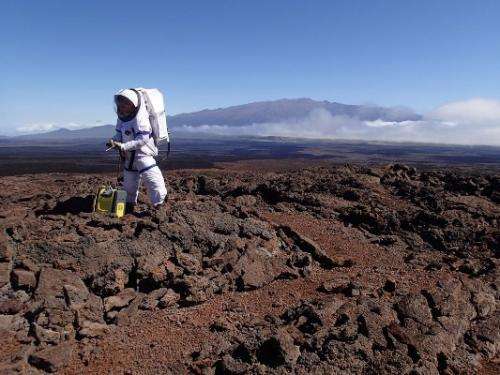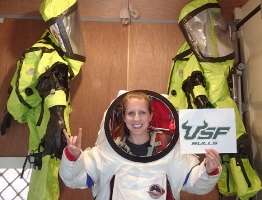Preparing for manned missions to Mars, engineer trains on Hawaii volcano

(Phys.org) —Chemical Engineering doctoral student Anne Caraccio is currently living in isolation on the slopes of the Mauna Loa volcano in Hawaii. She is participating in one of three University of Hawaii led missions that simulate the conditions future space explorers will experience living on Mars, a project known as HI-SEAS (Hawai'i Space Exploration Analog and Simulation). The current mission will last four months for the six-member crew, and two future missions will extend to eight and then 12 months.
The study focuses on the social, interpersonal and cognitive factors that affect team performance over time. A manned mission to Mars would take approximately six to nine months of travel just to reach the second closest planet to Earth, so it is vitally important for NASA to learn how a crew would adapt during a long-duration deep space mission.
"For a Mars mission, NASA (mission control in particular) would most likely have to hand over a lot of decisions to the crew since mission control will not be able to be as involved minute by minute with decisions and directions like they are on International Space Station," Anne said.
Some of the studies in the simulation are to advance cognition testing, reduce surveys given to crew to understand their mental and emotional situations and reduce the crew/ground control disconnect on missions, which will help in the selection process for long duration missions.
As a young child, Caraccio visited Kennedy Space Center and was awestruck. She had the opportunity to view a number of Space Shuttle launches in her classroom, as well as participation in a rocketry club in elementary school. With a combination of inspiration from her high school chemistry teacher and her older brother who studied engineering at West Point she decided on a career in chemical engineering.
While attending Manhattan College in New York City, where she received a bachelors and master's degree in chemical engineering, she timidly approached the NASA booth at a Society of Women Engineers career fair and applied for student opportunities, never thinking someone like her could work for NASA.

"I soon received two different student co-op positions and chose the research route," said Anne. After an accumulation of approximately 5 years, the majority of her research projects have focused on technology development geared toward human spaceflight. When the opportunity for a Mars analog for HI-SEAS came about, she thought her current research project at KSC would be a good fit for an analog study to boost the understanding of the technology on a long duration deep space mission.
This experience led to her to apply to the HI-SEAS program, an application process includes a class 2 flight medical, personal research project proposal, essays, interviews and education requirements. "Very similar to the fundamental NASA astronaut application baseline requirements," she added.
The crew, which lives in a dome-like structure, has dubbed her "Chief Engineer" as she carries out a few research projects while keeping a watchful eye on the habitat energy and utility use. She recently had to fix the liquid cooling systems of their spacesuits.
"So far, I've done everything from electrical wiring in our space suits to testing volatile organic compounds," she said. "Every day brings something new."
Her personal research during the simulation is from NASA's Logistics Reduction and Repurposing (LRR) project. LRR is a collaborative effort in which NASA is determined to reduce total logistical mass through reduction, reuse and recycling of various wastes and components of long duration space missions and habitats beyond low earth orbit. Trash-to-Gas aims to develop a technology that converts materials and biological and food waste into high-value products such as life support oxygen and water, rocket fuels, raw material production, feed stocks, and other energy sources.

"So far, there has not been a typical day, Anne says. "But there are some common things I do each day, which include measuring the waste generation, checking on the systems power and energy generation profiles, and recording our daily water and power consumption."
She was too young for the last formal NASA astronaut call. "For a Mars mission we still have a long way to go in our technology development for the mission to be effective and reliable for human space flight. But if the opportunity arises in the future, I will most likely apply," she said.
Her mission ends July 28, just in time for some R&R before the fall semester begins. In case a trip to Mars doesn't pan out in her future, she would like to continue with technology development for deep space missions that also have advantages for Earth applications. "Spaceflight projects also benefit our planet."
"Space travel is something I feel will never leave human nature, and I hope that my efforts in technology development and space enthusiasm can lead to a positive future for Earth and the aerospace field. I also hope to advance my education further by earning a PhD in chemical engineering from USF."
Provided by University of South Florida




















